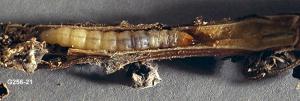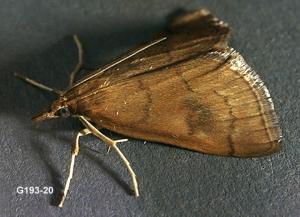|
MINT ROOT BORER MANAGEMENT |
|||||
|
Return to: |
Mint root borer larvae cause damage by feeding inside peppermint and spearmint rhizomes from late July through mid-September (Berry, 1974; Pike et al., 1988). Damage resulting from feeding injury weakens mint stands, which overwinter poorly and regrow slowly in the spring. SAMPLING Inspect fields during the growing season when adults are
active. When disturbed, adults fly a few feet and land on the underside of a leaf. Collect
moths by sweeping foliage, then shaking net contents to the bottom and slapping lightly
against a hard surface. Empty net contents onto a light background and remember to
distinguish mint root borer adult from false celery leaftier adult. Presence of adults in
a field should serve as a signal to take soil samples before harvest or as soon as
possible after harvest in August. If samples are taken in July or early August, larvae
will be very small and only found by the most skilled observer and should be extracted
with Berlese funnels (see Shields et al. 1981). Late
September and October soil samples will usually only detect larvae after damage is done
and results of chemical control will normally be poor. Soil samples (1 sq ft in size)
should be taken from several locations in the field. We recommend that two samples be
taken for every 2 1/2 acres. Take a minimum of 25 samples per field at several different
sites. Samples should include soil and rhizomes to a depth of 2 to 3 inches. These samples
also may be used to estimate the population of root weevil larvae and symphylans in the
fall, although the depth of samples may be too shallow to collect a representative sample.
Samples may be sorted by hand in the field, but we recommend the use of Berlese funnels to
separate the larvae from the sample. If using Berlese funnels, separate the soil and
rhizomes to enhance recovery of larvae. If samples are inspected in the field, be sure to
inspect rhizomes for damage and larvae which may be within the rhizome. Depending on soil
texture and moisture, the use of screens to sieve soil may speed up the process of
locating larvae in the samples that have exited rhizomes. Parasitic nematodes are
approved for use on mint to control mint root borer larvae. For best results, parasitic
nematodes should be injected through sprinkler irrigation during late July or early August
(preharvest) at a rate of 2.0 billion infective juvenile nematodes per acre (this
treatment also may control strawberry root weevil larvae). Postharvest applications during
September should be injected through sprinkler irrigation at a rate of 1.5 or 2.0 billion
juvenile nematodes per acre. The low rate is recommended for fields that have a low mint
root borer density (ca. less than 1.0/ft²), and the high rate is recommended for fields
that have densities greater than 1.0/ft². Parasitic nematodes must be applied in the
evening or at night because the nematodes are vulnerable to ultraviolet light during the
daytime. Before injecting the nematodes, irrigate the fields with a minimum of 1/4 inch of
water to prewet the soil surface. Immediately following injection, 1/2 to 1 inch of
sprinkler irrigation should be applied to the field. The nematodes may also be sprayed on
the field in the evening with a ground sprayer calibrated to deliver at least 50 gallons
of water per acre, followed immediately with 1/2 to 1 inch of irrigation. Carefully follow
the directions on the label to insure proper handling and injection of the parasitic
nematodes. Tillage after harvest has been shown to significantly reduce mint root borer. In southcentral Washington and parts of Idaho, strip tillage combined with Lorsban applied prior to mid-September provides 90 per cent or more control in furrow-irrigated mint fields (Pike and Glazer, 1982). In sprinkler-irrigated fields, plowing and double disking mint fields in late October or early November or in the spring during February or March provides 80 per cent or more control (Talkington, 1983; Talkington and Berry, 1986). Pike et al. (1988), in Mint Root Borer in the Pacific Northwest, PNW 322, describe these two tillage methods. Tillage may spread verticillium wilt; growers should use this practice only in fields with a low incidence of verticillium wilt. Growers may observe benefits from tillage, such as stand rejuvenation, suppression of some weed species, redistribution of nutrients, disruption of the layers of accumulated carbon and organic matter, and the establishment of uniform pH levels in the upper 4 to 6 inches of soil (Talkington and Berry, 1986). SEX PHEROMONES A sex pheromone is available commercially to sample for mint root borer adult males (Davis and McDonough, 1984; Davis et al., 1991). The successful development of this sex pheromone in a trapping system could provide valuable early-season information to growers concerning the need to control mint root borer larvae. Revealing the presence or absence of mint root borer adults in a field, concentration of adult activity in a certain area, and/or size of an infestation based on trap catches are examples of how pheromones have been used to successfully manage pests in other crops. More information on use of pheromones for mint root borer is found in a recent Mint Research Progress Report (Berry et al. 1991b, Berry et al. 1993). |


